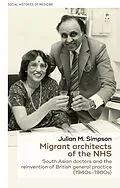Migrant Architects draws on 45 oral history interviews and extensive archival research to offer a radical reappraisal of how the National Health Service was made.
It tells the story of migrant South Asian doctors who became general practitioners in the NHS. Imperial legacies, professional discrimination and an exodus of UK-trained doctors combined to direct these doctors towards work as GPs in some of the most deprived parts of the UK. In some areas, they made up over half of the general practitioner workforce. The NHS was structurally dependent on them and they shaped British society and medicine through their agency.
This book is aimed at students and academics with interests in the history of immigration, immigration studies, the history of medicine, South Asian studies and oral history. It will also be of interest to anyone who wants to know more about how Empire and migration have contributed to making Britain what it is today.
Autorentext
Julian M. Simpson is an independent writer, researcher and translator
Klappentext
The NHS is traditionally viewed as a typically British institutionp; a symbol of national identity. It has however always been dependent on a migrant workforce whose role has until recently received little attention from historians. Migrant Architects draws on 45 oral history interviews (40 with South Asian GPs who worked through this period) and extensive archival research to offer a radical reappraisal of how the National Health Service was made. This book is the first history of the first generation of South Asian doctors who became GPs in the National Health Service. Their story is key to understanding the postwar history of British general practice and therefore the development of a British healthcare system where GPs play essential roles in controlling access to hospitals and providing care in community settings. Imperial legacies, professional discrimination and an exodus of UK-trained doctors combined to direct migrant doctors towards work as GPs in some of the most deprived parts of the UK. In some areas they made up more than half of the GP workforce. This book documents the structural dependency of British general practice on South Asian doctors. It also focuses on the agency of migrant practitioners and their transformative roles in British society and medicine. Migrant architects is aimed at students and academics with interests in the history of immigration, immigration studies, the history of medicine, South Asian studies and oral history. It will also be of interest to anyone who wants to know more about how Empire and migration have contributed to making Britain what it is today.
Inhalt
Introduction: Writing the history of the 'International' Health ServicePart I: Healthcare and migration in Britain during the post-war period1. The making of a cornerstone2.Empire, migration and the NHSPart II: The colonial legacy, racism and the staffing of surgeries 3. The empire of the mind and medical migration4. Discrimination and the development of general practice5. From 'pairs of hands' to family doctorsPart III: Shaping British medicine and British society6. 'The more you did, the more they depended on you': memories of practice on the periphery7. Beyond the surgery boundaries: doctors' organisations and activist medics8. Adding to the mosaic of British general practiceConclusion: Historicising a 'revolution' Appendix: Methodological approachIndex
